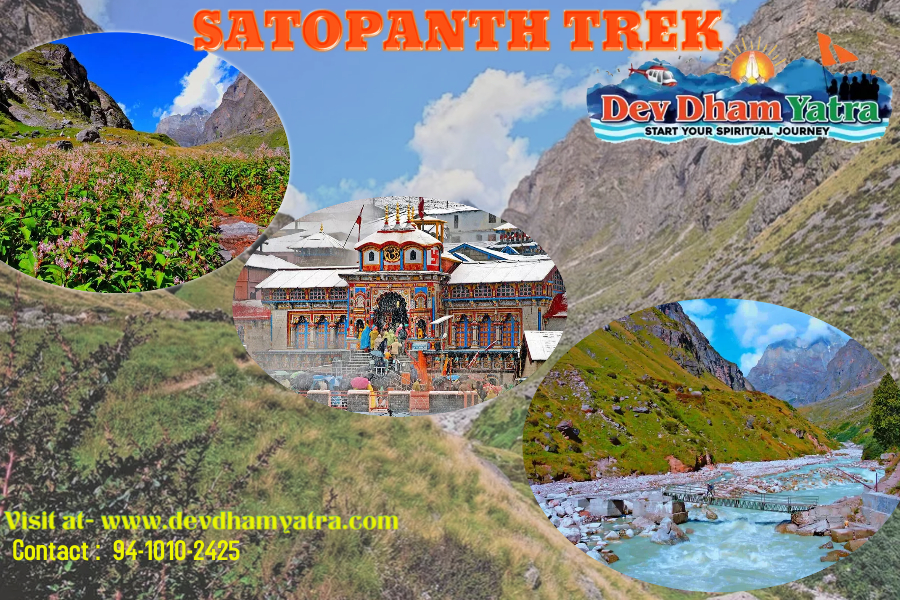Sathopanth Tal is located at the height of 4600 m above sea level in the bosom of the snow-capped Himalayas. The lake is a triangular shape with its turquoise color glistening in full potential during summer and remain frozen throughout winters. Located in the Chamoli district of Uttarakhand near to Badrinath temple, the lake also carries a religious significance.
Main Highlight of Satopanth Trek
- Latitude– 30.7456N
- Longitude– 79.3437° E
- Altitude Range– 4600m (15,100ft)
- Best Time To Visit- May to July
Table of Content
- Why Saopanth Trek?
- History of Satopanth Lake
- Itinerary for Satopanth Trek
- Best Time to do the Trek
- Things to Carry during the Trek
Why Satopanth Trek?
Satopanth Trek, a famous trek of Uttarakhand is not only known for its holiness and mysticism stories but also for the views that one comes across. The trail which stretches 50km presents some of the jaw-dropping views of the Himalayas. The journey begins from Badrinath, taking a trail that passes from Laxmi Van and Chakartirtha.
While going through the trek, one will be rewarded with – soul-soothing views of rivers originating from the Himalayas; snow-capped peaks of Mount Chaukhamba, Mount Neelkantha, Mount Balakun, and tranquility in the lap of nature.
History of Satopanth Lake
According to the legends, the TriMurtis Brahma, Vishnu, and Shiva meditated on the corners of this triangular lake. And on the occasion of every Ekadashi, the trio takes the dip in the lake. It is believed that people who take a dip in the holy water of the Satopanth lake are absolved of all the sins.
Lakshmi Van and Chakratirth too have their share of stories. The story about indent in Chakratirtha states that Lord Vishnu once kept his Sudarshan chakra on the valley which causes an indentation due to the weight of the chakra and hence it got its round shape surrounding the mountains. Whereas Lakshmi Van is still believed to be the place where Goddess Lakshmi and her husband Lord Vishnu penanced.
How to Reach Satopanth Trek:
By Air – You can take a flight up to Jollygrant Airport. From there you can take a taxi till Rishikesh and again for Badrinath or directly from the airport to Badrinath.
By Train – Board the train for Rishikesh and take a taxi/bus for Badrinath.
By Road – Board bus or cab till Rishikesh and then directly for Badrinath and person with their own vehicle can directly go to Badrinath via Rishikesh.
Hotels in Badrinath:
- Sarovar Portico
- GMVN Tourist Rest House
- Narayan Palace
- Badri Ville Resort
- Jagirdar Guest House
- Dwarikesh
Itinerary for Satopanth Trek:
1st day: Rishikesh – Badrinath Route(approx. 301km)
Take the bus from Rishikesh for Badrinath and have lunch en route. It will take approx. 11-13 hours to reach Badrinath. On reaching Badrinath, Visit the shrine and take the blessing of the Lord. Check-in at the hotel, take a rest and rejuvenate yourself for the next day.

Figure 1- Badrinath
2nd day: Badrinath – Lakshmi Van(Approx 9km)
Check out from the hotel and start your journey to the Mana village, the last village of India. You can take a local taxi for this or a short trek of about 3 km as per your requirement.

Figure 2- Laxmi Van Campsite
Get your permit verified( this inner line permit is necessary and you can get it from Joshimath). From Mana village, follow the trail on the left of the river Alaknanda. The properly built trail stretches about a few kilometers. Covering a few kilometers, your ear will be mesmerized by the sound of the water falling from graceful Waterfall Vasundhara. This waterfall is known for its medicinal properties which are scientifically proved. As you advanced the valley bifurcates into two, keep sticking to the left bank throughout the trek. Walk 3-4 km through moraines you will reach the Lakshmi Van campsite.

Figure 3- Vasundhara Fall
3rd day: Lakshmi Van – Charkratirth(Approx. 7km)
The trail for the Chakratirtha will be slightly difficult as the elevation gain will be more than 1100 ft. Keep yourself hydrated during the entire trek and make sure you had a healthy breakfast. Taking the trail, along the Alaknanda river your trek will be on grassland amidst moraines of the Dhano glacier.
On the trail you will come across some of the beautiful alpine flowers, blooming in the valley that will spellbind you. As your cross this patch, you will get a glimpse of the 3 peaks of Bhagirathi if the weather is clear. Moving further a distance of a few 5-6 km you will reach Sahastradhara (the name called so because of hundreds of small waterfall plunging through the single rock). On the left side rest Mount Neelkanth. Try to reach the Chakratirtha Camping site as soon as possible as afternoon the weather may change drastically. It’s a flat grassland where you can set your tent.
4th day: Chakratirtha – Satopanth Tal – Chakratirtha
Be ready to be enchanted by the view the next day early morning with Balakun range on your right, Mount Neelkanth on left, and Mount Chaukanmba at the middle.

Figure 4- Satopanth Lake
The trek would be 10-11 km long and would be a difficult one. Initially, the trekking will be on a flat grassland. As you move further, you will meander through the boulders and moraines so try to be patient. On reaching the ridge top, you will the very first glimpse of Satopanth Lake. Near the lake, you will find a shelter made from stone, home to Saint Mauni Baba who has taken on silence for a long time. It is believed that he can survive on air and sun even if no food is available. Taking some rest from the tedious journey, you can start descending towards Chakratirtha campsite and reach within few hours.
5th day: Chakratirth – Mana – Badrinath(Approx 15-16 km)
Take the same trail to reach the Mana by crossing the Lakshmi Van. It may take about 5-6 hours. From Mana, you can even hire a taxi if tired enough to not move further. Once you reached Badrinath, check-in at a hotel and take a rest.
6th day: Badrinath – Rishikesh
Once you have rejuvenated yourself, check out from the hotel and leave for Rishikesh.
Best Time to Satopanth Trek
The best season for taking the trek is the month of May to July. As in this month, you will get to see the beautiful flowers, green meadows, and crystal clear Satopanth lake.
Things to Carry During the Trek
Water Bottles, flashlights, Trekking shoes, Basic Medical Kit, Trackpants/Trousers, Backpack, Sunscreen, Energy bar, Powerbank.




















